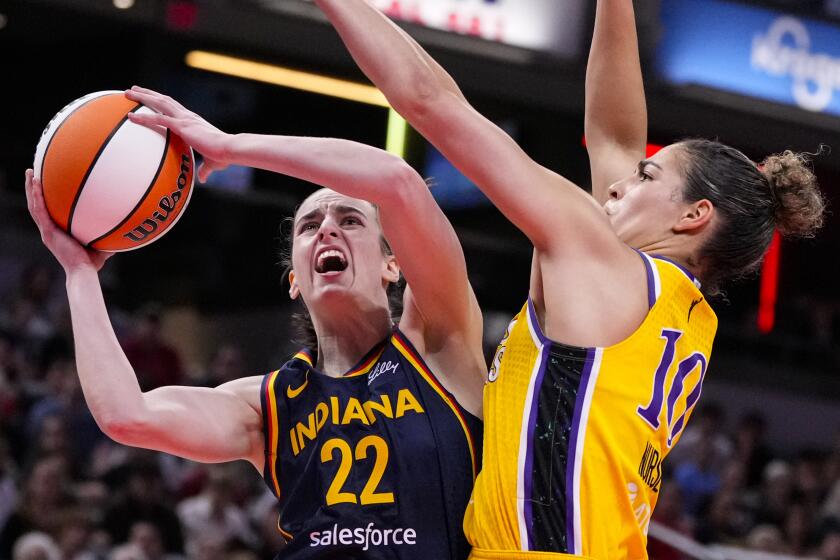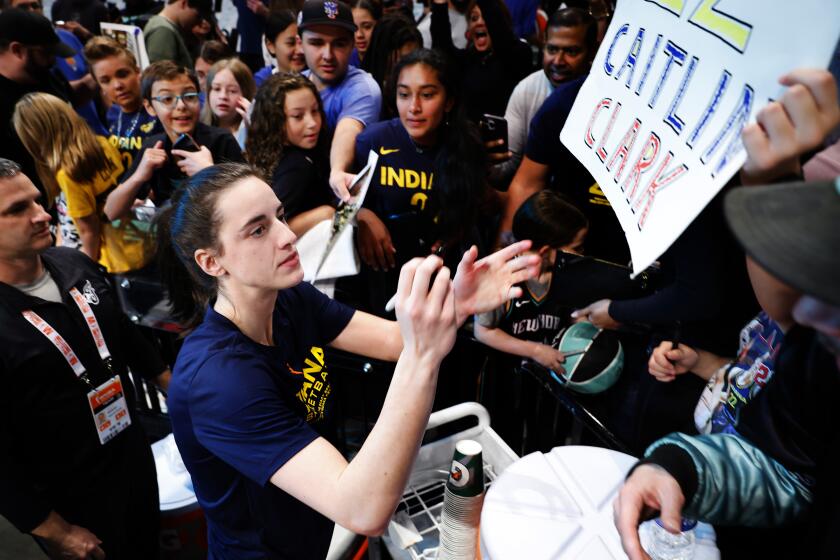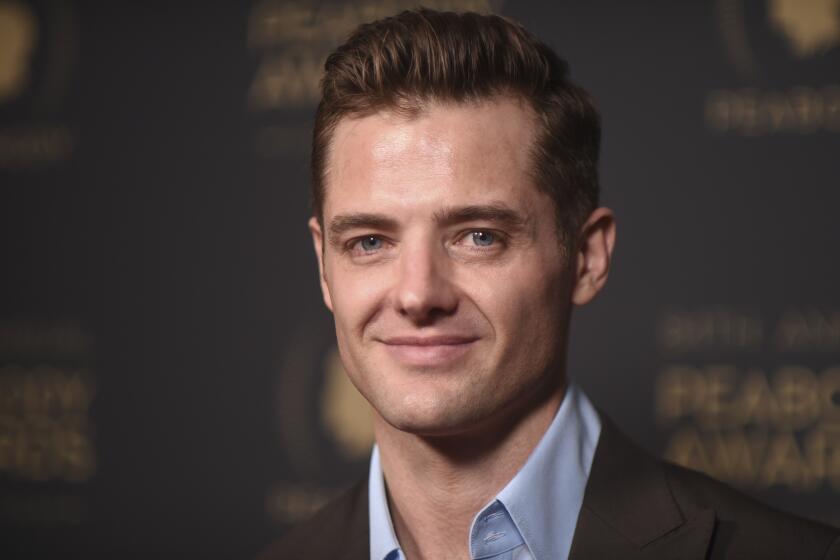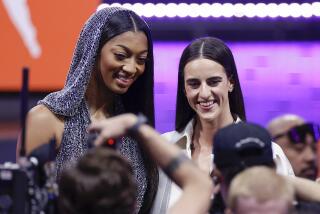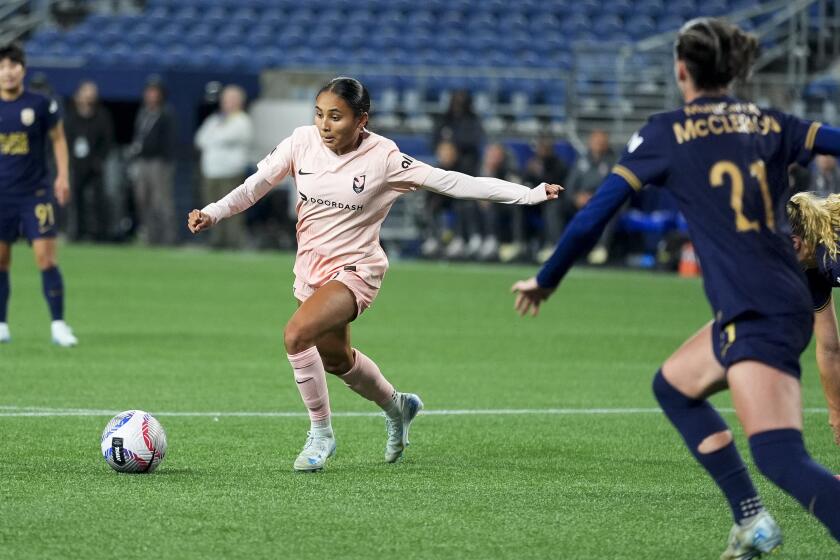Brandi Chastain’s iconic moment aided women’s movement from field to owner’s box
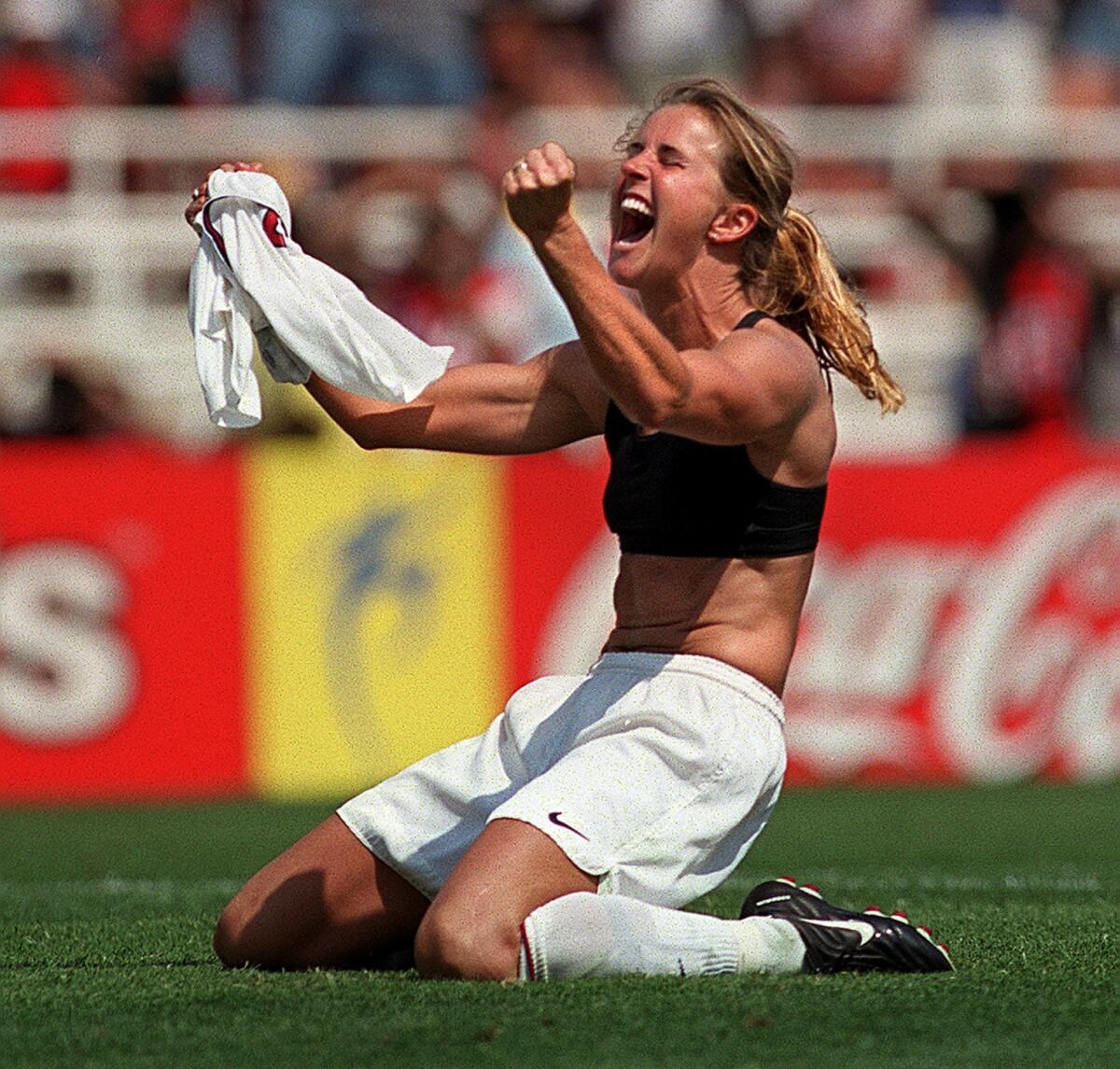
- Share via
It’s one of the most powerful images in women’s sports history.
Brandi Chastain, after converting the penalty kick that gave the U.S. its second women’s World Cup title, dropped to her knees and ripped off her jersey in celebration, exposing her black sports bra to a live crowd of 90,000 and a national television audience that peaked at 40 million.
Twenty-five years later it’s still celebrated as a moment of unbridled joy, but also one of liberation. Never before — or since — has a team of women athletes played before a crowd that large in the U.S. And rarely had a woman athlete felt so unburdened by societal constraints that she started taking her clothes off in public.
“That was an iconic moment but it transcended sport. People saw the raw emotion in that photograph and it made people feel differently about women,” said Chrissy Franklin, an executive vice president with the sports and entertainment marketing firm Octagon. “She opened the door for women to be unapologetic about their success.”
At first, Caitlin Clark says she doesn’t see people using her name as a weapon in culture wars. Later on, she says it’s disappointing they use her name to push racism and misogyny.
If Title IX, Billie Jean King and Florence Griffith Joyner changed the way we thought about women athletes, Chastain and her teammates began to change the way we watched, consumed and supported women’s sports. It has been a long, slow and painful evolution, one that is still far from finished even as Caitlin Clark draws record crowds to WNBA arenas and the NWSL nearly outdraws the Cubs at Wrigley Field.
But Chastain’s journey from the floor of the Rose Bowl to the owners’ suite at PayPal Park, where the NWSL franchise she founded plays, is proof that progress has been made.
“Obviously the trajectory of women’s sports has skyrocketed in the last couple years and that has been a game-changer,” said Chastain, one of a growing number of women who have moved from the playing field into the executive offices of women’s soccer and basketball teams. “I think men in business, who have been decision-makers, now look at women’s sports as not just a charitable organization. We’ve been saying for 25 or more years that women’s sports has a place in the landscape and it’s viable.”
Cheryl Cooky, a professor of women’s, gender and sexuality studies at Purdue, agrees. This moment, she said, finally feels different.
“Part of why we’re seeing what we’re seeing is because women athletes are taking the reins,” said Cooky, who has been studying the intersection of gender, sports, media and culture for more than three decades. “Women athletes today are creating their own media platforms, becoming owners and investing in women’s sports.
“I really do think it’s women athletes who are starting to really push the conversation, invest in women’s sports, speak out against injustices.”
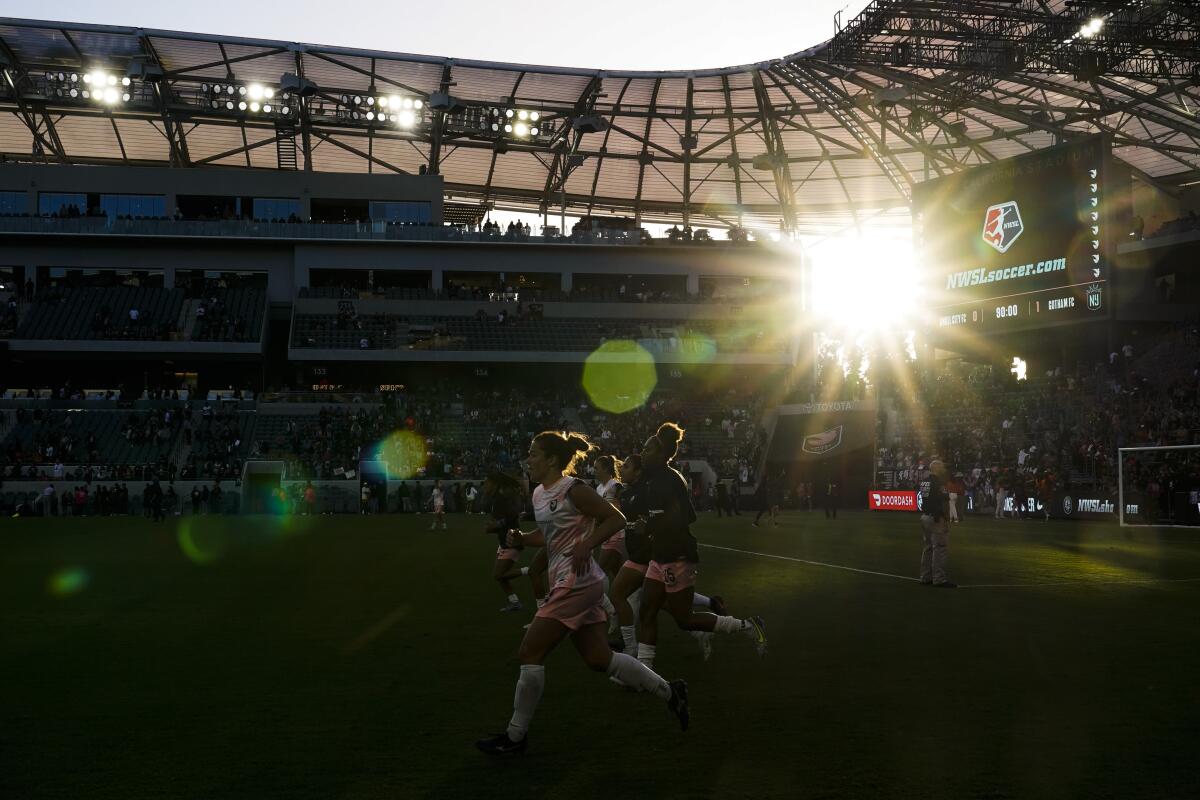
Few U.S. professional sports franchises were owned by women in 2013, when the NWSL played its first season with eight teams. Since then the league has nearly doubled, to 14 teams, eight of which have women as owners, founders or significant investors. Chastain is all three for Bay FC, an NWSL expansion franchise she started with three other national team players.
On Saturday, Bay will play host to Angel City, a third-year club whose sprawling group of more than 100 owners and investors includes 14 former USWNT stars, two Wimbledon women’s champions and Olympic gold medalists in skiing and gymnastics.
Other NWSL minority owners include former World Cup champions Carli Lloyd and Briana Scurry, basketball’s Sue Bird, tennis champion Naomi Osaka and gymnast Dominique Dawes. Partly as a result of their investments, the league is stronger than ever, with a record four-year, $240-million domestic broadcast deal, record average attendance and two more expansion teams scheduled to begin play in 2026.
Angel City alone has been valued at $180 million by the sports business website Sportico, making it the most valuable franchise in U.S. women’s sports history. And it’s run by the largest majority-women ownership group in global sports. No longer do women athletes have to rely solely on men in business to make decisions about their livelihoods, a problem that repeatedly sunk women’s sports just two decades earlier.
“We do ourselves a disservice,” Cooky said, “if we don’t recognize all the work and all the effort that women athletes have put in, both on and off the field, to make this moment happen.”
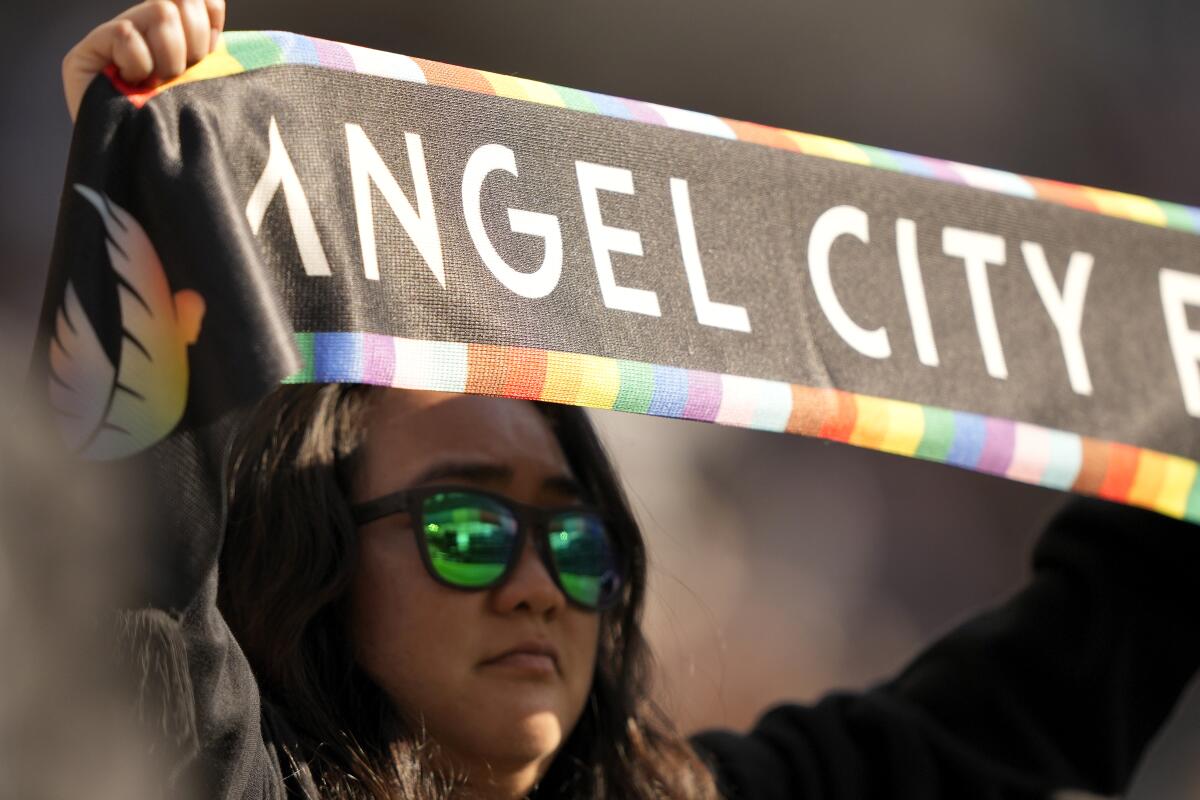
There was a lot of patience involved, too. A year after Chastain’s penalty gave the U.S. a World Cup title, she joined 19 other national team players in forming the Women’s United Soccer Assn., the first in a series of short-lived women’s soccer leagues in the U.S. The WUSA folded three seasons later, but the problem wasn’t with the players, it was with the investors.
“Business executives and decision-makers were not ready for women’s sports at the time,” Chastain said. “This is not a short-term investment. Women’s sports has not been given the breathing space that men’s sports has, and so it’s hard to grow. And it hasn’t been given the nourishment to grow into what it can fully be.
“Now it’s breathing on its own, it’s healthy. The sponsorship space, the business space, we’re seeing what impact we can have.”
And it’s not just the NWSL. The WNBA has long struggled to draw fans and sponsors, but with Clark joining after a record-setting college career at Iowa, the league recently released figures showing attendance was up 156% in the first month of the season and more than half of all league games had been sellouts. Televised games on ABC and ESPN averaged 1.32 million viewers in May across ESPN, ESPN 2, ABC and CBS, three times as many as they did last year.
Caitlin Clark has attracted a new wave of support for WNBA players, but some question why veteran Black WNBA stars didn’t get the same boost.
So can you draw line from Chastain kneeling on the floor of the Rose Bowl to Clark draining shots from the midcourt logo today? No, says Joy Fawcett, a teammate of Chastain’s on three World Cup teams. Agreeing with Cooky, she says seeing Chastain’s success reflected in Clark’s doesn’t do justice to the difficulty of the journey, nor the contributions so many others made along the way.
“It wasn’t a straight line,” said Fawcett, now an Angel City investor. “It was a lot of ups and downs to get to this point.
“This is something that takes a village. You have none of this without the fans and their support. You have nothing without the investors. It’s all layered over time and none of us could do it alone.”
But Fawcett, the first coach of UCLA’s women’s team and now an assistant with the national deaf soccer team, said she and her teammates never doubted this day would come.
“We always believed that it’s like ‘you just need to see it,’” she said. “You just need to watch the women’s game. It’s a beautiful game. You will love it. You just need to come.
“And that’s what happened. They did, and it took off.”
Twenty-five years later Chastain keeps a framed copy of that iconic photo in her San Jose home, though humility prevents her from displaying it in a prominent place.
“It’s in the bathroom,” she said.
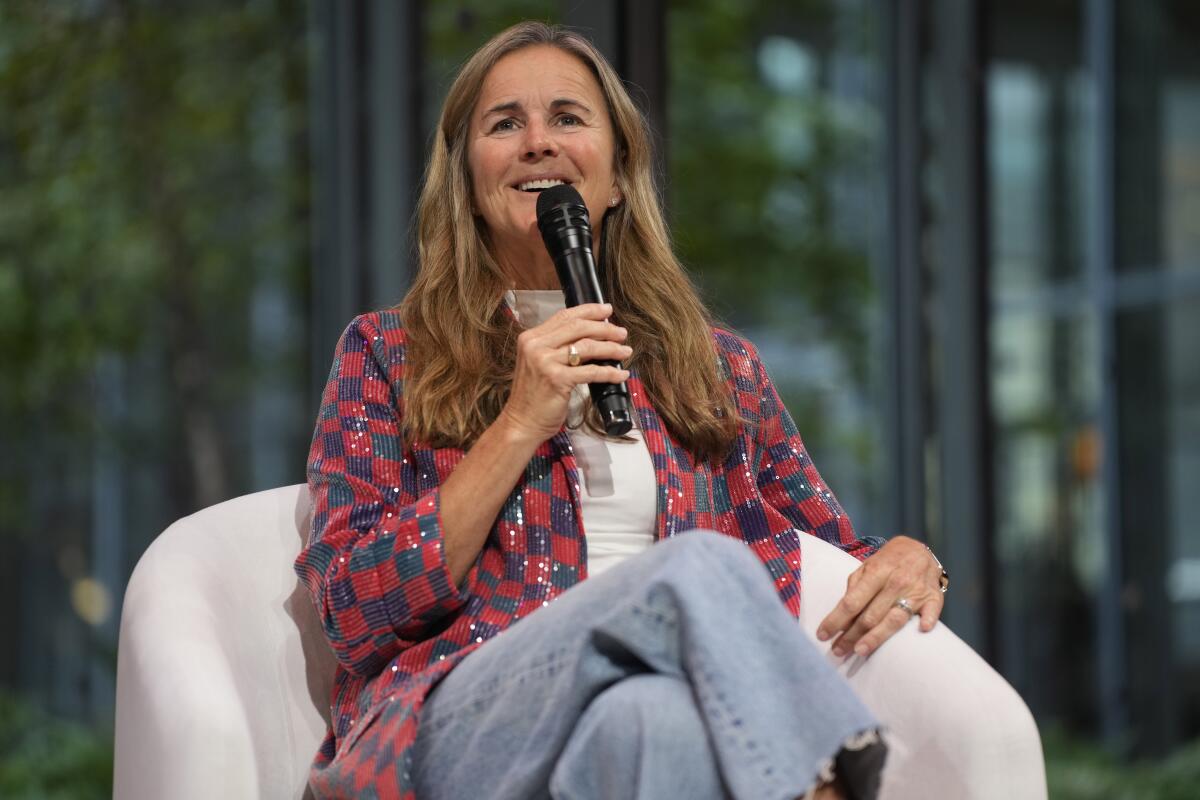
But then Chastain doesn’t need a picture to be inspired, which is how the photo came to be in the first place. Her mother Lark raised her daughter to be the kind of woman who wasn’t afraid to take her shirt off in public if the moment called for it or to start a professional soccer team from scratch. However she did that not with words, but deeds.
Lark Chastain dreamed of becoming a flight attendant but was told she couldn’t keep the job if she married or had children — rules that didn’t apply to male flight attendants. So she quit, married and raised a family before returning to the work force, eventually becoming the vice president of a Silicon Valley employment agency.
While Brandi Chastain was winning World Cups, her mother was filling the board rooms at Hewlett Packard and IBM, arguably influencing the direction of the tech revolution.
While it might seem as though the acceptance of gay athletes never evolved, former Galaxy star Robbie Rogers has become a family man and pioneer in entertainment.
“There was no reason for her to think she could do that. She was told she could be a nurse, a secretary or a teacher,” Brandi said of her mother, who died in 2002. “I saw that example every day in front of me. Her fearlessness gave me the power to stand up and say: ‘I love sports. I belong in this space.’ I will take pride in knowing that I was gifted something really powerful from my mom.”
So maybe there is a straight line from Chastain to Clark after all, only it’s Lark Chastain who blazed that trail by questioning whether the way things have always been done is necessarily the way they should continue to be done.
“What Caitlin Clark has been gifted,” Brandi said, “is women who have been showcasing powerful strength and confidence. So she too believes she belongs in that space.”

